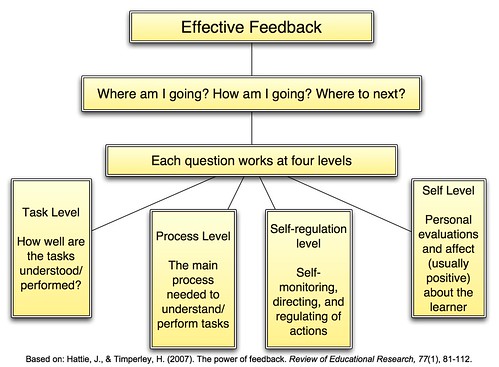Thoughts on Feedback
It's not surprising then that when teachers talk about feedback what they often mean is marking and correcting. If we define feedback as merely a response provided by a teacher, then marking and correcting certainly fall into that category. Viewed from this perspective, feedback can be completely useless. It can be ignored or rejected by the student. We need to move beyond this behaviourist input-output model and embrace a different definition of feedback, one that aims to close a gap between what has been grasped by the student and what still remains to be grasped (Sadler, 1989). Feedback must provide the information necessary to help students close that gap. It must be seen as "information with which a learner can confirm, add to, overwrite, tune, or restructure information in memory, whether that information is domain knowledge, meta-cognitive knowledge, beliefs about self and tasks, or cognitive tactics and strategies" (Winne & Butler, 1994, p.5740). In addition, "feedback is more effective when it provides information on correct rather than incorrect responses and when it builds on changes from previous trails" (Hattie & Timperley, 2007, p.85). According to Hattie and Timperley (2007), effective feedback must also help students answer the following three questions:
1. Where am I going (What are the goals?)2. How am I going (What progress is being made toward the goal?)
3. Where to next? (What activities need to be undertaken to make better progress?)
Unfortunately, too often the response to these questions is reduced to a grade or a checkmark, sometimes accompanied by a short comment. Too often, feedback operates on what has been referred to as "level of task performance" or the "self or personal level" (Hattie & Timperley, 2007) which is often unrelated to the task and offers a congratulatory statement, such as "Well done!", or a more critical one, such as "More effort needed."
To be effective, feedback needs to operate at the "level of process of understanding how to do a task" or the "regulatory or metacognitive process level" (Hattie & Timperley, 2007) - the two middle levels in the following diagram:

It's time to join our students where true learning takes place, it's time to support them as they process ideas and chat about their thoughts. These online places that exist in many classrooms today are not a frill but
The rest of my research on the blogging community documents, among other things, my attempts to develop a new persona for myself in the online community. What I eventually developed relies on very conversational engagement with students. It relies on providing feedback by engaging students in conversations about their work. In other words, I learned how to effectively participate in the online interactions among my students and how to support the learning that takes place through these interactions - on individual blogs and in student discussions that develop as comments and trackbacks.
My research helped me develop new ways of engaging students in conversations. That shift also shows that feedback is much more than what happens after the students submit their work.